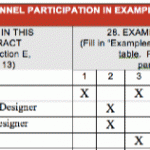More proposal graphics. More proposal graphics. I hear it all the time from “marketing experts,” contemporaries, and Principals. Put more graphics in your proposals.
I even heard it from a client once. Here’s the story.
A Grain of Salt For Proposal Graphics
We had a debrief with a water authority on the west coast. This was a “long shot” proposal. Our experience wasn’t exactly on point. But I thought we had a shot because they provided the exact scoring formula, including how the price would weigh in. I figured, knowing the competitor’s rates, I could put a competitive price together that might make up for our lack of on-point experience.
Boy, was I wrong. In the overall proposal scoring, we ranked very low. The client cited our lack of images and the amount of text as the reason we lost. They gave examples of how other firms loaded up on the graphics.
Really? Let’s test that. I had the scoring criteria and all the scoring results. So, I had my assistant run the numbers.
What would we have scored if we took price out of the equation? It turns out we would have come in a very close second, if not for the price.
My approach would have worked, but I was “out priced.” More graphics would not have helped at all. In fact, the technical proposal did better than I expected.
That’s Not It
I think we can all agree that graphics are good to put in your proposals. I’m certainly not going to argue that. But why do you put graphics in a proposal?
You might think graphics illustrate a concept visually and make it easier to comprehend. Well, that’s true. But it’s not the reason for the graphic.
You might think a logo reinforces your brand in the mind of the client. Sure, but that’s not the reason either.
You might think a photo shows how awesome that project your firm contributed to was. And it may, but that’s still not it.
The Real Purpose
The purpose of any graphic in a proposal is to get the evaluator to read the text on the page. Your message is in the text. Your message is what’s going to sway things in your favor.
I don’t care if you are doing proposals for Frank Gehry. I don’t even care if you are doing a proposal for graphic design.
The letters and numbers in your proposal will make or break you. (Click Here To Tweet That)
A graphic needs to get the proposal evaluator to look at the words. That’s its job. If it doesn’t do that job, it has failed.
Key Takeaway: Put graphics in your proposal to get the reader to your message.






There is little doubt that graphics can be overdone in design and construction industry proposals. What should not be underestimated, however, is the power of a well-designed graphic to replace (not simply complement, as you suggest) written narrative. All graphics, photos, matrices, flowcharts, and tables need context, of course, but a well-done graphic may effectively reduce the need for a 200-word explanation to a 15-word caption. If we merely wanted the selection committee to read the proposal, would bold/italicized text not do a better job than a “distracting” photo or rendering?
Jeff,
Thank you for commenting. I’m all for changing a 200-word explanation to a 15-word caption.
I’m not sure bold or italicized text is a good idea. But if you see an awesome photo for a project, you’re gonna want to know more about the project. So, you start reading the text.
In contrast, if you look at a photo of a project that doesn’t really look impressive or relative to what you are trying to accomplish…you won’t be likely to read any of the text.
Nobody wants to read a sea of text. You have to be constantly pulling the proposal reviewer back to your message. Headlines, images, and graphics are the tool you use to do this.
Great response, thanks Matt. I would never advocate for bold/italicized text either. In the sense that graphics should complement accompanying narrative and ultimately bring a reader back to the written theme/message at hand (as opposed to losing them in the photo or graphic), I hope all fellow proposal managers take your suggestions to heart. A graphic intended only to “break up the text” is likely to do more harm than good.
Jeff,
Totally agree. Hey, did I see you got a promotion? Congrats. Clearly, it’s well deserved!!
Great article and thought provoking. As I was reading, I thought…hum…sadly I think we have devolved to placing many of the images in our proposal to fill in blank space. On one-page project write-ups for sure we do not always have enough complelling text so we jsut throw a couple of project photos at it. Looks good at a glance, but totally misses the point. Sometimes you just need someone to point out the obvious to you. Thanks for the post.
Julie,
You are welcome! 🙂
Matt —
This is a very interesting piece of work, but given our “upbringing” (what we’ve been taught), somewhat counterintuitive. So many of us were taught, and continue to assume, that since “a picture is worth 1,000 words,” the purpose of graphics was to give the client LESS to read. If he can understand your graphic he doesn’t have to read so much of your text.
I do agree with Jeff that a graphic can replace a big block of text. But I think this only works for the writer who already understands the value of what he/she is writing. However, the more I think about it, Matt, the more I am convinced that you are correct. A picture can govern whether the reader truly reads, merely skims or skips over your writing; it doesn’t allow him/her to get bored with the page. But using the picture, with or without a caption, to carry the idea is a case of using the wrong tool for the job.
Thanks for the interesting post.
Bernie,
As always, thank you for reading and entering into the conversation.
Interesting take on the use of graphics and I see the point. I also agree with Jeff about the “picture being worth a thousand words” concept. We try to use overview graphics in our technical approach sections to orient the reader (tell them what you’re going to tell them) prior to giving them in the details. I also believe that graphics give the reader a chance to catch their breath every now and again. And the visual treats of headlines, callout boxes, and images helps to reinforce your themes and benefit statements.
Will,
I totally agree. Thank you for your comment.
This is a subject near and dear to my heart. I have NO graphic design ability but have learned from a few awesome designers the right way to us graphics in a proposal. It seems to be a constant struggle between the ‘make it pretty’ requests of technical staff and making sure the graphics are relevant. I agree that a graphic designed to replace pages of text are essential (for example a project timeline). But the graphics have to also support and supplement the text of your proposal.
Jen,
I totally agree! Thank you for your comment!
I love the statement, “The letters and numbers in your #proposal will make or break you.”
Then don’t forget to tweet it! 🙂
Thank you for the comment.
Hi Matt. You make a good point here. I’d like to add that folks in the business development/marketing business can really limit what can be included under the term “graphics.” If you think about it, such things as pull-quotes and call-out boxes can also be considered graphics, when it comes to the function of breaking up the dreaded “wall of text” in a proposal.
I think that’s the real reason to use graphics: as part of a layout scheme that keeps the reader’s eye engaged (but not confused or overloaded) and their mind interested. Graphics should compliment your content and break up boring text blocks while serving to further convey your message. Just dropping in charts and images, etc. for the sake of the graphics trend is really annoying.
By the way, in addition to graphics, I hear more and more about the vaunted “white space.” Sure, I like white space, but things are getting a bit over the top. It seems to be part of a “proposal as magazine” movement.
I concur.
Ironically, I hear about “too much whitespace.” I think the purpose of whitespace is to aid readability. I used to see proposals that had the left half of the page empty with text on the right. In my opinion, I’m not sure that’s a good use of whitespace.
Note: I’m not a graphic designer, so that’s not my area of expertise.
Hi Matt! My initial read had me reacting in total disagreement. But having read it a few more times and the comments as well, I realized that, actually… I agree. I believe in developing highly-custom proposals with succinct messages and targeted, proving graphics that support those messages. Those graphics are quite often comprised of text and numbers – pie charts, bar charts, etc. with real data that emphasize the writing. So “The letters and numbers in your proposal will make or break you” still applies. The push to include “more” graphics is the wrong emphasis… Because more is not better. It’s just more. It’s the choice between quantity over quality. The focus should be on quality whether it’s graphics or text that’s included. More text does not make a better proposal either.
Fawn,
I’m glad you took the time to read this and really think about it. Thank you for commenting.
You nailed it. Pictures are an aid, not the story.
I agree that graphics should be used intelligently, There should always be a caption that relates the graphic (including photos, to the message. But there is another reason that has not been addressed — not all of the evaluators process information the same way. A good proposal will accommodate the skimmers, the visually oriented, the technically oriented reviewers.
I have really enjoyed reading the comments about this subject. Graphic design is not my strong point, writing good content is. A comment we got back once from a reviewer was to put a picture on every page so I have gotten into the habit of doing this – mostly random pictures, e.g. if it is an educational facility proposal, miscellaneous photos of students, etc. The message I am trying to send is that what we do is focused on them and what they do. Anyone want to comment on this approach?
Michele,
One image per page is not a bad approach. Universities (and schools in general) are often sensitive when it comes to people taking photos of their students. But a stock image probably isn’t a bad idea. But again, the point is to get them reading the text. Connect a message with the picture.
What your client was saying is they don’t want to read a sea of text. I don’t blame them. Who would?
They just recognize that adding photos means they won’t have to read (or skim) as much information.
I could go down a rabbit hole with this, but do you really think the reason you didn’t win was the competition had more photos? I highly doubt it.
If you need a brutally honest proposal critique, contact me and I’ll send you a link.
Thanks Matt, I will do that in the new year. Have the flu and can’t take brutal honesty right now.
Get well soon!
Great article! I am new to this industry and this article really made me think about what I put into proposals. We do tend to drop photos in to fill space and I am now thinking of what will draw the reader. Excellent read!
Thank you!
Matt
As a proposal manager and graphic designer I absolutely disagree. (Respectfully of course). If you are using your graphics to encourage the evaluator to read your text then the graphic is meaningless. As a trained graphic designer, each and every graphic must stand on its own without the complement of the text. The graphic alone should allow you to receive a compliance or responsiveness check mark. Allowing your evaluator to retain more but read less and that’s is a fact.
Are you saying the purpose of the graphic is to replace the text?
If so, that would lead me to believe that a buyer could reasonably make a decision just by looking at the graphics.
Is that your position?
Sure. Of course. If I can clearly and compellingly describe my recruiting process in a graphic, it replaces lengthy narrative. Thank you for your reply.
Traci,
Let me throw this idea at you for consideration. If you could convince someone to buy using only a graphic, wouldn’t the advertising industry have figured this out yet and exploited it? Wouldn’t every ad, every direct mail piece (in this multi-billion dollar industry), be made up of only a graphic?
Why do all ads have copy? Why aren’t ads taking this tact?
The Shipley Guide (which I’m sure you are aware of and truth be told I’m not a huge fan of) contradicts itself regarding graphics. They say, “…when evaluators both see and read the same point, they recall six times as much.” Then the book seems to advise what you are saying…use graphics instead of text. That contradicts what they claim the research says.
I’m not trying to belittle your point, it’s a valid point. I just see it a bit differently.
Blank space in a proposal? Who has that anymore? More than ever we are kept to a 20-page limit, with font no smaller than 10-pt. With 61 years of relevant project history, that makes it tough to get all you want to convey in, without loading it with graphics. Any more, we just put in the pictures of the relevant projects that we are talking about on that page.
Hi, D Mills. You’re right in saying 20 pages is though. We do want more room to talk about ourselves. But we can speak better about how we’d benefit the client by using choice words, phrases, and concision. As an award-winning writer I wouldn’t want to work without a graphics person, nor would I want to replace him. Knowing how to spin sales-speak into persuasive anecdotes and analogies, and utilizing your skills to demonstrate thinking from the client’s perspective takes quality writing.
Finding the right blend of graphics and text is what happens when a graphic designer and a prop writer collaborate. Another good example of the right ratio of these is in design magazines like Architectural Record. The editors know how to use graphics to draw in the reader, which is all of us industry folk, yet they also know how to use a blend of captions and poignant text.
What is your thought on the “typical” graphics such as team org chart, project schedule, project renderings, etc.? I’m a fan of either making them extremely beautiful and maybe out of the norm BUT super easy for an old person to read and grasp instantly. Because every proposal will have these I believe you need to make yours visually interesting even if you are proposing on a wastewater treatment facility.
As far as org chart and schedule, I don’t advise people to get “fancy.” Keep it simple. Give them the information they want. Don’t make getting that information hard for them. (i.e. Don’t make them think)
I read this in something you wrote some years ago, and a light went on in my brain. I had already had some negative experience with proposals that were “over-designed,” and this thought crystalized my thinking into something I could explain to others. As publishing and presentation software has developed over the last two decades, so has the tendency to overuse them. Like a kid getting his first box of 64 Crayola crayons, who thinks he has to use every color in every picture. Thanks for repeating this, Matt. It definitely bears repetition.
If possible, a few examples of the “good” use of graphics contrasted with the “poor” use of graphics would provide context for the concepts being discussed.